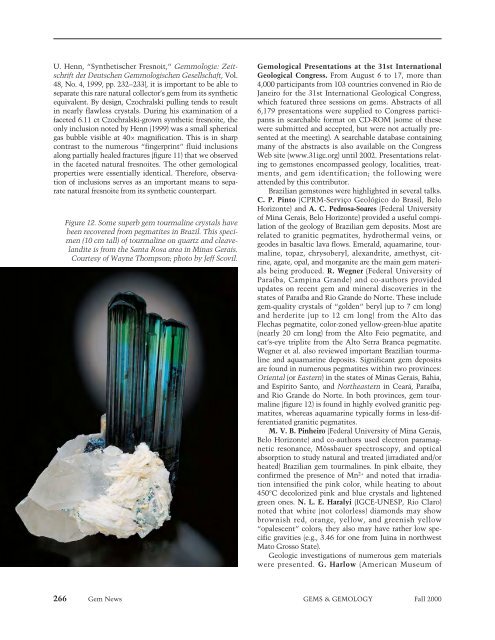Fall 2000 Gems & Gemology - Gemfrance
Fall 2000 Gems & Gemology - Gemfrance
Fall 2000 Gems & Gemology - Gemfrance
Create successful ePaper yourself
Turn your PDF publications into a flip-book with our unique Google optimized e-Paper software.
U. Henn, “Synthetischer Fresnoit,” Gemmologie: Zeitschrift<br />
der Deutschen Gemmologischen Gesellschaft, Vol.<br />
48, No. 4, 1999, pp. 232–233), it is important to be able to<br />
separate this rare natural collector’s gem from its synthetic<br />
equivalent. By design, Czochralski pulling tends to result<br />
in nearly flawless crystals. During his examination of a<br />
faceted 6.11 ct Czochralski-grown synthetic fresnoite, the<br />
only inclusion noted by Henn (1999) was a small spherical<br />
gas bubble visible at 40× magnification. This is in sharp<br />
contrast to the numerous “fingerprint” fluid inclusions<br />
along partially healed fractures (figure 11) that we observed<br />
in the faceted natural fresnoites. The other gemological<br />
properties were essentially identical. Therefore, observation<br />
of inclusions serves as an important means to separate<br />
natural fresnoite from its synthetic counterpart.<br />
Figure 12. Some superb gem tourmaline crystals have<br />
been recovered from pegmatites in Brazil. This specimen<br />
(10 cm tall) of tourmaline on quartz and cleavelandite<br />
is from the Santa Rosa area in Minas Gerais.<br />
Courtesy of Wayne Thompson; photo by Jeff Scovil.<br />
Gemological Presentations at the 31st International<br />
Geological Congress. From August 6 to 17, more than<br />
4,000 participants from 103 countries convened in Rio de<br />
Janeiro for the 31st International Geological Congress,<br />
which featured three sessions on gems. Abstracts of all<br />
6,179 presentations were supplied to Congress participants<br />
in searchable format on CD-ROM (some of these<br />
were submitted and accepted, but were not actually presented<br />
at the meeting). A searchable database containing<br />
many of the abstracts is also available on the Congress<br />
Web site (www.31igc.org) until 2002. Presentations relating<br />
to gemstones encompassed geology, localities, treatments,<br />
and gem identification; the following were<br />
attended by this contributor.<br />
Brazilian gemstones were highlighted in several talks.<br />
C. P. Pinto (CPRM-Serviço Geológico do Brasil, Belo<br />
Horizonte) and A. C. Pedrosa-Soares (Federal University<br />
of Mina Gerais, Belo Horizonte) provided a useful compilation<br />
of the geology of Brazilian gem deposits. Most are<br />
related to granitic pegmatites, hydrothermal veins, or<br />
geodes in basaltic lava flows. Emerald, aquamarine, tourmaline,<br />
topaz, chrysoberyl, alexandrite, amethyst, citrine,<br />
agate, opal, and morganite are the main gem materials<br />
being produced. R. Wegner (Federal University of<br />
Paraíba, Campina Grande) and co-authors provided<br />
updates on recent gem and mineral discoveries in the<br />
states of Paraíba and Rio Grande do Norte. These include<br />
gem-quality crystals of “golden” beryl (up to 7 cm long)<br />
and herderite (up to 12 cm long) from the Alto das<br />
Flechas pegmatite, color-zoned yellow-green-blue apatite<br />
(nearly 20 cm long) from the Alto Feio pegmatite, and<br />
cat’s-eye triplite from the Alto Serra Branca pegmatite.<br />
Wegner et al. also reviewed important Brazilian tourmaline<br />
and aquamarine deposits. Significant gem deposits<br />
are found in numerous pegmatites within two provinces:<br />
Oriental (or Eastern) in the states of Minas Gerais, Bahia,<br />
and Espírito Santo, and Northeastern in Ceará, Paraíba,<br />
and Rio Grande do Norte. In both provinces, gem tourmaline<br />
(figure 12) is found in highly evolved granitic pegmatites,<br />
whereas aquamarine typically forms in less-differentiated<br />
granitic pegmatites.<br />
M. V. B. Pinheiro (Federal University of Mina Gerais,<br />
Belo Horizonte) and co-authors used electron paramagnetic<br />
resonance, Mössbauer spectroscopy, and optical<br />
absorption to study natural and treated (irradiated and/or<br />
heated) Brazilian gem tourmalines. In pink elbaite, they<br />
confirmed the presence of Mn 2+ and noted that irradiation<br />
intensified the pink color, while heating to about<br />
450°C decolorized pink and blue crystals and lightened<br />
green ones. N. L. E. Haralyi (IGCE-UNESP, Rio Claro)<br />
noted that white (not colorless) diamonds may show<br />
brownish red, orange, yellow, and greenish yellow<br />
“opalescent” colors; they also may have rather low specific<br />
gravities (e.g., 3.46 for one from Juina in northwest<br />
Mato Grosso State).<br />
Geologic investigations of numerous gem materials<br />
were presented. G. Harlow (American Museum of<br />
266 Gem News GEMS & GEMOLOGY <strong>Fall</strong> <strong>2000</strong>


